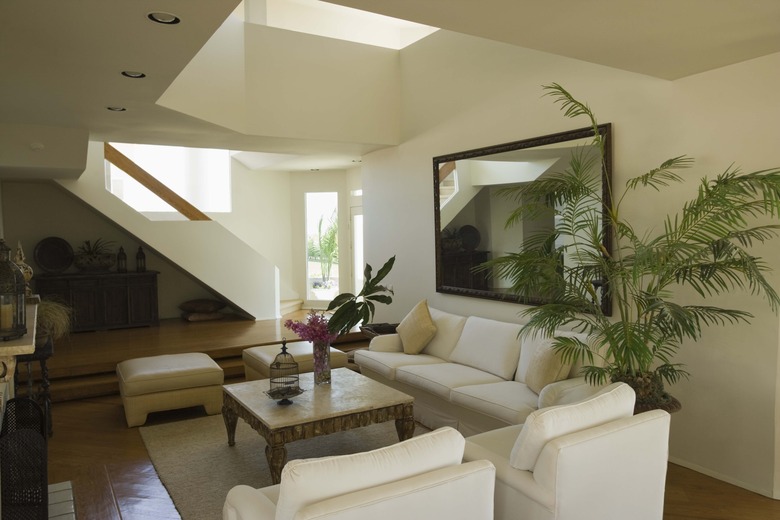Indoor Plants For Northern Exposures
As urban sprawl encroaches on the beauty of nature, houseplants offer a way to connect with the natural world from inside. While making our homes more attractive, indoor plants also convert carbon dioxide to oxygen, and trap and absorb some pollutants. Adequate light is the most crucial factor in the well-being of a houseplant. In general, green foliage plants tolerate lower-light locations better than those that flower or have variegated leaves.
Step 1
Of the four exposures, a room on the northern side of a house provides the least light, as well as heat, all year. The amount of light coming to a northern windowsill translates to the intensity found at least 8 feet away from a south-facing window. Though northern exposures seldom experience direct sunlight, the low light conditions may be further lessened by the presence of trees outside that may shade at times, wall color reflection, roof overhangs, window dressing, the day length, the time of day and the season.
Smaller Plants
Step 1
Surprisingly, many plants will grow in a northern exposure. Certain groups of houseplants tend to fare well there, although some varieties under these headings do not. Ivies, ferns and African violets are examples of relatively small houseplants that often thrive in a northern exposure. Grape ivy (Cissus rhombifolia) and Swedish ivy (Plectranthus australis) like a north-facing window. So do bird's nest fern (Asplenium nidus), maidenhair fern (Adiantum raddianum) and holly fern (Crytomium falcatum). Unlike most flowering plants, some varieties of the African violet (Saintpaulia ionantha) bloom in a northern exposure.
Step 2
Step 3
- Of the four exposures, a room on the northern side of a house provides the least light, as well as heat, all year.
- Though northern exposures seldom experience direct sunlight, the low light conditions may be further lessened by the presence of trees outside that may shade at times, wall color reflection, roof overhangs, window dressing, the day length, the time of day and the season.
Larger Plants
Step 1
Houseplants that grow too large for a window ledge, or at least that feature spreading leaves, have representatives happy in low-light conditions. Some palms, philodendrons and dracaenas can flourish in a northern exposure. The parlor palm (Chamaedorea elegans), bamboo palm (Chamaedorea erumpens) and lady palm (Rhapis excelsa) are all adaptable to such an environment. A number of philodendrons thrive in a north-facing room, including the fiddle-leaf philodendron (Philodendron bipennifolium), the philodendron cultivar "Emerald Queen," and the heart-leaf philodendron (Philodendron scandens ssp. oxycardium). Also partial to low light, the corn plants "Janet Craig" and "Warneckii," both cultivars of Dracaena deremensis, as well as the corn plants Dracaena fragrans and Dracaena marginata, favor a northern exposure.
Signs of Too Little Light
Step 1
If a plant located in a north-facing room displays any of the following signs, consider moving it to an eastern exposure, which receives slightly more sunlight. Indications of inadequate light include dropped leaves, new leaves that are smaller than the old ones, long stretches between nodes on the stems, and plants that are bending toward the light source. Other hints might be slower growth and lighter green new foliage. Even if a plant is growing but its leaves appear thinner than normal, it likely used stored sugars and starches in order to grow.
Step 2
- Houseplants that grow too large for a window ledge, or at least that feature spreading leaves, have representatives happy in low-light conditions.
- Indications of inadequate light include dropped leaves, new leaves that are smaller than the old ones, long stretches between nodes on the stems, and plants that are bending toward the light source.
References
- University of Georgia Cooperative Extension: Growing Indoor Plants with Success
- The Garden Primer; Barbara Damrosch
- Missouri Botanical Garden: Indoor Plants or Houseplants
